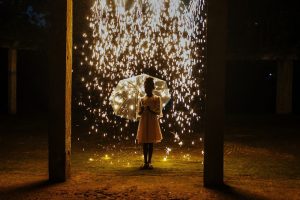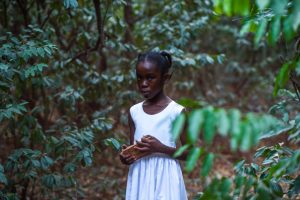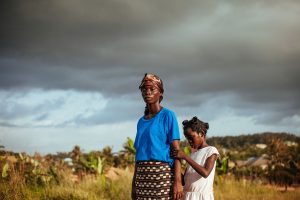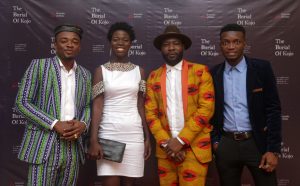THE BURIAL OF KOJO: CURIOUS VISUALS & ELECTRIC FEELS
Written by Ethel-Ruth Tawe
Ice water sweats in the palm of my hand as I look to the captivating stillness on screen. I move further into the stomach of a packed hall, ease into my seat, and scan a room full of proud smiles gazing at a portrayal of themselves on the widescreen.The Burial of Kojo was a gift to self, offered as a collective experience which expands on African oral traditions and allegories of a metaphysical journey. The film sparks a vital conversation about the intersections of heritage, politics, and spirituality here in Ghana and in Africa at large.
It tells a tale of two brothers, Kojo and Kwabena, whose tumultuous relationship spirals when Kwabena’s wife dies on their wedding night in an accident caused by Kojo. The story is told through the voice of Kojo’s young daughter Esi. Embodying the future, Esi represents a generation tackling a complex conversation between the present and an ancestral plane of sorts, where her dreams lead her to uncover truths about the masked rivalry between her father and uncle Kwabena. The plot is non-linear, playing on facets of time and space through a magical realist lens. Esi cares for a Sacred Bird that is hunted by a mysterious crow, lending it a thread of symbolism and foretelling. When her father goes missing, Esi sets the Sacred Bird free to encounter him again. As her mother Ama and a local detective struggle to locate Kojo, Esi is often shown running, alluding to the pressures of running out of time. She is wise beyond her years, taking on the role of her father’s keeper in a tender relationship where they are ever-present in spirit and flesh.
This award-winning screenplay is written and directed by Samuel Bazawule, a renowned hip-hop artist who goes by the stage name Blitz the Ambassador. His music has long fused traditional and contemporary sonic elements, with accompanying ethereal videos detailing lived-experiences in Africa and the diaspora. In this same storytelling tradition, Bazawule reintroduces his homeland Ghana to the world in The Burial of Kojo,highlighting the neglected beauty of the everyday in an unconventional manner. We begin inside our minds, led by curious visuals and electric feels, as the opening scenes provoke familiar memories yet ressemble mysterious terrains. We transition between urban and rural, into dreamscapes and landscapes animated on inverted screens with delicate treatment of colour, shadow-play, and sound. I am reminded of the fluidity between life and afterlife, of navigating through bliss and pain, and of elusive memories from my childhood which resurface through the eyes of the young narrator Esi.
As the plot unveils, we are forced to face politically charged undertones that deal with corruption, galamsey(illegal gold mining), and unemployment in Ghana. The social, spiritual, and emotional implications of the risks taken by the marginalized, Kojo and his family, are linked with the jarring realities of police bribery and Chinese-led neocolonial activity in Africa. However, the people, emotions, and culture remain central in this narrative as the film provides insight into the intimacies of family. As much as it is a tale of betrayal, survival, and exploitation, it is equally about ontology, purpose, and innocent curiosity. Through the inclusion of metaphorical characters, The Burial of Kojoprompts us to reimagine dimensional binaries and the coexistence of ‘utopia’ and ‘dystopia’ in an African terrain. The incorporation of a foretelling telenovela, with a parallel narrative to that of Kojo and Kwabena, adds a twist to this play on spatial awareness. Elements of afrofuturist spaces, much like Black Panthers’Wakandaor the Kingdom of Orïshain Children of Blood and Bone, are visualised through riveting cinematography that alternates our senses between mind and matter.
The Burial of Kojois an affirmation of the power of representation and a jolt in the culture of visual storytelling. The research and time poured into this production is evident in the questions we are forced to ask ourselves and the symbolisms that stretch of our imaginations during the viewing experience.
At the Accra premiere Q&A session, Bazawule urged young African film enthusiasts to take advantage of our backyards, where our natural environments are ready-made film sets which others struggle to recreate elsewhere. The powerful visuals in The Burial of Kojostreamline the beauty in simplicity throughout Africa. Bazawule reiterates that when challenged by finances, we must hone the currency of time and nature. For him, Africans need to continue defining our narrative, writing ourselves into the future, and reversing the foreign gaze that has long plagued us. There is a necessity for organised advocacy, investment, and ownership within the industry to allow space for self-determination. At the premiere, the energy in the room swelled at the relatability of black bodies dancing to a classical ensemble fused in a scoring that pays homage to sounds from northern Ghana. Through audiovisuals with songs of affirmation arranged by Bazawule himself, the film creates space for reflection, to tap into indigenous spirituality and cultivate self-consciousness. On a global scale, Bazawule’s work aims to build empathy and familiarity with nuances of African experiences and our shared humanity.
The Burial of Kojotranscends film into a critical movement; thus a catalyst for championing this medium of storytelling in Africa. Despite the ‘major star’ culture in Ghana, which relies of celebrity endorsement and recycling the ‘big hitters’, this independent film was able to break from the mold in numerous ways. From a hugely successful crowdfunding campaign, winning Best Narrative Feature(World Cinema) at the 2018 Urban Film Festival in New York, becoming a 2019 Pan African Film Festival (PAFF) Official Selection,building work ethic and casting the fresh faces that greeted us at the end of the premiere.The Burial of Kojo’s fully Ghanaian cast stars Cynthia Dankwa, Joseph Otsiman, Mamley Djangmah, Kobina Amissah-Sam, Ama K. Abebrese, Henry Adofo, Anima Misa, Joe Addo, and is co-produced by Kwaku Obeng Boateng and Bazawule, along with a predominantly Ghanaian crew. This production marks an affirming moment which I was privileged to experience in its birth home.
At the Accra premiere | Left to Right: Kwaku Obeng Boateng (Co-Director), Mamley Djangmah (Ama), Blitz Bazawule (Writer and Director), Joseph Otsiman (Kojo)
The Burial of Kojo comes to theatres in Spring 2019. Upcoming previews are in NYC (Feb 26th), and the DMV (March 7th). Watch the official trailer hereand look out for updates @theburialofkojo. The film will premiere on Netflix on March 31, in tandem with a national screening tour in the U.S.
Article adapted from “Magical Realism in Accra” (Africa Is A Country).
Photography Credit:Ofoe Amegavie
Ethel-Ruth Tawe(b.1994, Yaoundé, Cameroon) is a multidisciplinary artist engaging dialogue on identity, alternate realities, and diaspora cultures. She holds an MSc in Development Studies from SOAS University of London (2018), and a BA in International Human Rights, minoring in Art History & Criticism (2016). Find her @artofetheltaweon Instagram, Twitter& Facebook.








